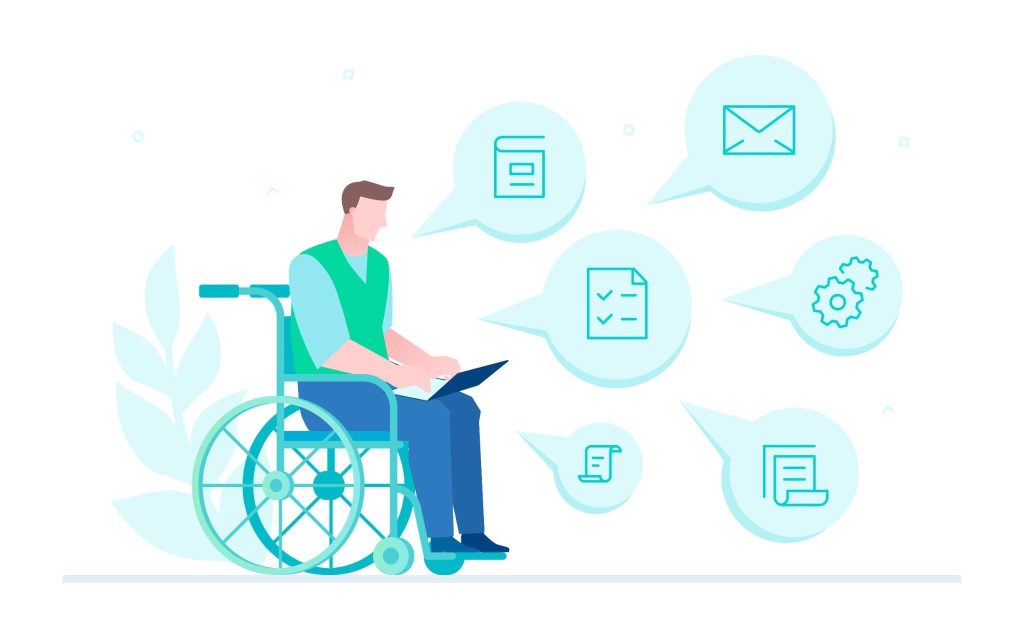If you have a medical condition that prevents you from working, you may want to take advantage of federal disability programs. Social Security disability benefits can help you cover household expenses and necessary services. Find out what programs are available, program requirements, how to file, and how to prepare for your disability interview.
What is the Disability Program?
There are two disability programs available through the Social Security Administration (SSA): the Social Security disability insurance (SSDI) program and the Supplemental Security Income (SSI) program. Both programs are designed to help those with proven disabilities earn a source of income.
The official definition of disability from the SSA office is anyone unable to engage in any substantial gainful activity due to a medically determinable physical or mental impairment. This condition must be expected to result in death or has lasted and will last for a continuous amount of time, not less than 12 months.
The definition of disability may vary slightly for children. A child who qualifies for either disability program must have a medically determinable physical or mental impairment that comes from an anatomical, physiological, or psychological abnormality. This condition must be proven through either clinical or laboratory techniques.
SSI Vs. SSDI Programs
Two SSA programs offer disability insurance. Understanding the difference between each one can help you decide which program is right for you.
Supplemental Security Income (SSI)
Supplemental security income (SSI) is a program that benefits seniors and people with disabilities with limited income. SSI benefits are also often supplemented by state programs. Eligibility for SSI is based on age/disability and income. Typically, only people with limited income and resources will qualify for the SSI program. Medicaid benefits are also linked to the SSI program in many states.
Social Security Disability Insurance (SSDI)
Social security disability income (SSDI) is a program that provides disability payments to those with a qualifying work history. Spouses and children may also qualify for this program without work history, as long as they have a family member with enough work contributions credited to the program. Medical Eligibility for SSDI is based on a qualifying disability and sufficient work credits.
Additionally, most people who qualify for SSDI will also qualify for Medicaid healthcare.
There are also differences between the two programs regarding when benefits begin and the average value and maximum benefits you can receive. SSI recipients can begin receiving benefits the first full month after approval. SSDI recipients may have to wait six months to receive benefits.
Keep in mind that these averages and limits change annually. As of 2023, the benefits for SSI are a maximum of $914 (single) and $1,371 (married). The average benefit for SSDI is $1,470 per month, with a maximum of $3,627 per month based on work history.
Health insurance benefits also slightly differ with each program. Those on SSI automatically qualify for Medicaid after being approved for the program. Those on SSDI automatically qualify for Medicare after a 24-month waiting period.
It is possible to receive both SSI and SSDI benefits. As long as you have a sufficient work history and low income, you may be eligible to collect from both programs.
Qualification Requirements for Disability
In general, you must meet one of the following requirements to submit a disability claim:
-
You are a disabled worker younger than retirement age.
-
You have been disabled since childhood and depend on a parent who receives title II disability or retirement benefits.
-
You are a disabled widow/widower between the ages of 50-60 with a spouse who receives benefits from Social Security.
Claimants who are under the age of 18 years with limited income may be eligible for disability payments.
The first step in filing for disability is visiting a local SSA office. Depending on where you live, these offices may sometimes be called Disability Determination Services (DDS) offices. Even if you apply for SSI online, it will still be processed through your local SSA office before then going to the Disability Determination office.
Do I qualify? Find out more information about what to expect during disability determination with SSA.
If you’re still not sure if you qualify for disability benefits, it can be helpful to check out the Social Security disability checklist. The checklist provides you with a clear list of all information you’ll need before filing.
When to File for Disability
You should file for disability as soon as you become disabled and can no longer work. It can take a while to find out if you’re eligible for disability benefits. Even if you are eligible, you may be denied multiple times, which means it may be months before you receive benefits. Some disability programs also have a waiting program, so it’s best to begin the process as soon as possible.
How to File for Disability
You can file for disability insurance with the following steps:
Choose Your Program
Decide which disability benefits you’re eligible to receive. Consider your age and work history when choosing the best program.
Both SSI and SSDI are available through the Social Security Administration, so the application process will be similar.
Choose Your Preferred Application Method
You can file for disability in one of the following ways:
-
Online: You can apply for disability benefits online at the Social Security website.
-
In-person: You can apply in person at your local Social Security office. However, most offices require that you make an appointment before arriving.
-
By phone: You can also apply for disability benefits by phone at 1-800-772-1213 between the hours of 7 a.m.- 7 p.m.
The fastest method to apply for disability benefits is online. When you submit your disability application online, you don’t have to wait for your local office to schedule an appointment. Another benefit to applying online is that you can easily check your application status. You can use the easy Social Security website to track where your application is at in the process.
Collect Personal Information
You’ll need certain information to fill out the disability application in full. Some information that you may need includes:
-
Completed application
-
The legal name of the disabled applicant
-
Legal address
-
Spouse’s information
-
Marriage and divorce records
-
Military records
-
Social Security number
-
Information about any dependents
-
Citizenship papers, if applicable
-
Educational information, including the highest educational grade you completed
-
Direct deposit bank information
-
An alternate contact person different from the applicant
In addition to including this information in your disability application, your local office may ask for physical documents. Some documents they may request from you include a copy of your birth certificate, proof of U.S. citizenship, military discharge papers, W-2 forms, medical records, and payment documents.
Collect Employment Information
SSA will request certain employment information from you. This includes information like:
-
The date your disability began affecting your work
-
The type of jobs you had before developing the disability
-
The specific duties of previous or current work
It can be helpful to create a list of all current and previous employers. Be as detailed as possible when including your work responsibilities and duties.
Collect Medical Information
You’ll also need to include important medical information in your disability claim. This includes the contact information of all medical sources (name, address, and phone). While there are physicians who primarily work with those applying for disability, the SSI department typically considers reports from your own medical professional more trustworthy.
If the DDS needs additional information about your medical condition, they may also reach out to their own medical resources. They may even require that you receive another medical evaluation from one of their approved physicians. You’ll be responsible for paying this cost, which varies between states.
You’ll need all medical records and reports from any and all physicians related to your disability condition. This includes medical doctors, vocational rehabilitators, public health welfare officials, mental health counselors, and prison or jail staff.
How to Prepare for Your Disability Appointment
A disability interview may be a part of your claims process. Preparing for your interview ahead of time can help you know what to say and what not to say. If you’re wondering, what might hurt my claim, here are a few things not to say during your disability appointment:
-
Claiming you’re able to work: Avoid claiming that you’re able to work and that the only reason you’re not working is that you haven’t been able to find employment. If you’re confident you can work, you likely won’t qualify for disability benefits.
-
You’re not currently receiving medical treatment: Not receiving treatment for your medical condition or not being under the direct supervision of a physician can also reduce your chances of being approved for disability benefits. You’ll need clear, updated medical records to improve your chances of being approved.
-
Lying about your symptoms: It’s also important to be truthful about your symptoms and condition. You’ll work closely with medical professionals who can easily pick up on lies or exaggerations. It could hurt your credibility, even if you make one small, inaccurate statement.
-
Not giving enough information: Some applicants may try to be brief with the information they give in hopes of not saying something wrong. However, the more detailed your application is, the better the chances of being approved. Be as specific and clear as possible when describing your condition.
Filling out a few forms before going to your interview can also be helpful. Fill out the Adult Disability Interview checklist from the SSA to know what to expect. You can also use the Adult Medical and Job Worksheet to keep track of all employment. This worksheet requests information about your most recent employers and medical conditions.
If English isn’t your first language, you can also request an interpreter before going in for your disability interview. Make sure you request this accommodation ahead of time because an interpreter may not be available if you wait.
What to Do After Applying for Disability
After submitting your disability application, your local field office will verify your information and review your claim. The SSI department will verify all nonmedical information, including your name, age, location, and residency. Once they complete this step, they’ll forward your medical evidence to the DDS office. Here, they’ll verify your eligibility for disability benefits.
First, the DDS will collect information about the disability from the applicant’s claim. The DDS is fully funded and regulated by the federal government. The determination team includes a medical or psychological consultant and DDS state employees. DDS may schedule a consultative examination (CE) if they don’t have sufficient evidence available.
This allows them to collect information in addition to what you include in your claim. The DDS then makes its determination using the information gathered from both sources.
The DDS may either accept or deny a claim, or in some cases, they may also refer applicants to the state vocational rehabilitative (VR) center. Once DDS decides, they forward the base back to the SSI department, who handles all communication with you.
While not common, it’s also possible for DDS to rule an applicant as presumptively disabled or blind, meaning they can receive disability payments while they await the disability decision. These payments, however, are maxed out at six months. It’s also important to note that if DDS determines that the applicant is not disabled, they may have to repay all payments. This presumptive payment is also not available for those filing under the Title II disability program.
DDS considers the following sequential evaluation process when determining disability eligibility:
-
If the applicant has any work activity
-
The severity of the applicant’s disability
-
Whether or not the disability meets or medically equals an eligible listing
-
The applicant’s ability to perform any previous work duties
-
The applicant’s ability to work based on their age, education, or experience
DDS only applies steps one through three when determining the disability eligibility of applications of those under 22 years. Applications of those over 22 years will include a careful review of each step.
If SSA Approves Your Disability Claim
If DDS and SSA approve a disability application, they will calculate how much the person should receive compensation and benefits. They will send you your first check shortly after.
SSDI typically requires applicants to wait a minimum of five months after the disability date to begin collecting benefits. Children are not subject to this same waiting period. The waiting period also doesn’t apply to applicants disabled due to amyotrophic lateral sclerosis (ALS).
Because of recent changes to the program, anyone who files on or after July 23, 2020, is also not subject to a five-month waiting period. If you apply for disability today and are approved, you can begin receiving disability payments in as little as one month of eligibility. If you qualify for SSI benefits, you can begin collecting them the first full month after you file your claim.
If SSA Denies Your Disability Claim
If DDS and SSA deny your disability application, they will send you a letter. They will then hold on to your application and documents in case you decide to appeal.
You have the right to appeal if you are denied your disability claim. This is done through the Social Security Administration’s Office of Hearing Operations (SSA) (OHO).
Filing a reconsideration gives you the chance to have a different team review your claim. If this team also denies your application, you have the chance to then argue your case in front of a state administrativ
judge. You also have the opportunity to add any additional information to your application during this step.
The administrative judge may also try to collect their own evidence, such as reaching out to your medical resources directly. They also have the ability to issue a subpoena, which requires the medical professional to submit their documents or even testify in court.
Under the Freedom of Information and Privacy Act, the federal government must share all information in your application with you. This means you can review any third-party physician reports that may have led to your denied claim. If you’re still not satisfied with the disability decision, you can request a review by the Appeals Council. You can file an appeal in writing and send it by mail, in-person, or online to your local office.
The reconsideration process is done at the state level. If you’re still unsatisfied with the decision and believe you haven’t been given fair consideration, you can take your disability claim to the federal level. This requests a judicial review in a Federal court.
What Happens After You’re Approved for Disability?
Once approved for disability, you should get benefits for life. Unlike some other federal programs, you don’t have to reapply for disability benefits yearly. However, the SSA does conduct periodic reevaluations of eligibility. Whether or not you’ll be subject to these reevaluations depends on the severity of your disability. Life-long disabilities may not receive revaluations as frequently as those that could potentially improve over a period of time.
The good thing is that these reevaluations are not typically as long and drawn out as the initial application process. If you have a condition that requires frequent reevaluations, it can be a good idea to prepare for these reviews ahead of time. Keep track of all your medical documents and ensure you’re keeping up with all medical check-ups and follow-ups.
It’s also important to notify SSA of any improvements to your medical condition. Failing to do so could lead to expensive financial and legal difficulties. You could also lose your disability coverage.
Social Security does issue cost of living benefits most years. This increase occurs in January and is equal to the standard cost of living rate. Once you reach retirement age, your disability benefits convert to retirement benefits. The amount of benefits you receive should stay the same, though.
Can You Work While Collecting Disability?
Some people may also wonder about their work eligibility after being qualified for disability payments. SSA provides those on disability with a work incentive. This means that you won’t lose your disability benefits for testing out your ability to work. The specific rules vary depending on which program you receive. However, both offer some form of benefits, even if you choose to test working.
While working shouldn’t take away your disability benefits, it’s still important to notify the SSI office of any income. Even minimal income should be reported to avoid affecting your eligibility. You can continue receiving disability benefits for up to nine months during a trial work period. If you require special assistive services or machinery to do your new job, you should also notify SSI of these costs.
SSI also has a Ticket to Work program. If they deem you able to work with assistance, they may issue you a ticket. You can take that ticket to one of the approved employers. SSA may offer some people work incentives to test their ability to work.
Disability Payments and Children Dependent Eligibility
The dependent of someone on disability can receive payments up to the age of 18 years. If the child is disabled, they may continue receiving their benefits. The parent should receive a letter around three months before the child’s 18th birthday outlining what they need to do to maintain disability payments.
Children 18 years or older and in school can continue receiving benefits until 19 years. The state may also allow the child to receive benefits for the rest of the school year, even after they turn 19.
How to Receive Your Benefits
Because you include your direct deposit bank information in your initial application, receiving your benefits is easy. You should receive your pre-calculated payments each month. The date that you receive benefits depends on your birthday. This date matches the applicant’s birth date, which means it may come on your spouse’s date.
As of 2011, Social Security benefits are no longer available in paper checks. All payments are now directly deposited to your bank. There is the option of using a Direct Express card instead.
Another program available through SSA is the Achieving a Better Life Experience (ABLE) account. This savings account helps disability claimants save money while helping them deal with disability-related costs. Any money added to this account doesn’t count toward disability benefit eligibility, as long as the ABLE account doesn’t exceed $100,000. The claimant can then use these funds for any cost related to their disability, including housing, transportation, assistive devices, or education.
Disability and Medicare or Medicaid Payments
Disability is a great way to cover household costs and bills, especially if a disability prevents you from working. For some, it may not be enough. Fortunately, most states also allow people who qualify for SSI disability to receive Medicaid.
You may be eligible for Medicare after receiving your disability benefits for 24 months. While Medicare is a different program, you may qualify for low-cost benefits if you also receive disability payments or are considered low-income. For example, your state may cover your premiums and out-of-pocket medical expenses.
Some claimants on disability may also receive Supplemental Nutrition Assistance Program (SNAP) eligibility. This program helps recipients cover food costs. You can also reach out to your local U.S. Department of Health & Human Services to find out what other programs you may be eligible for.




